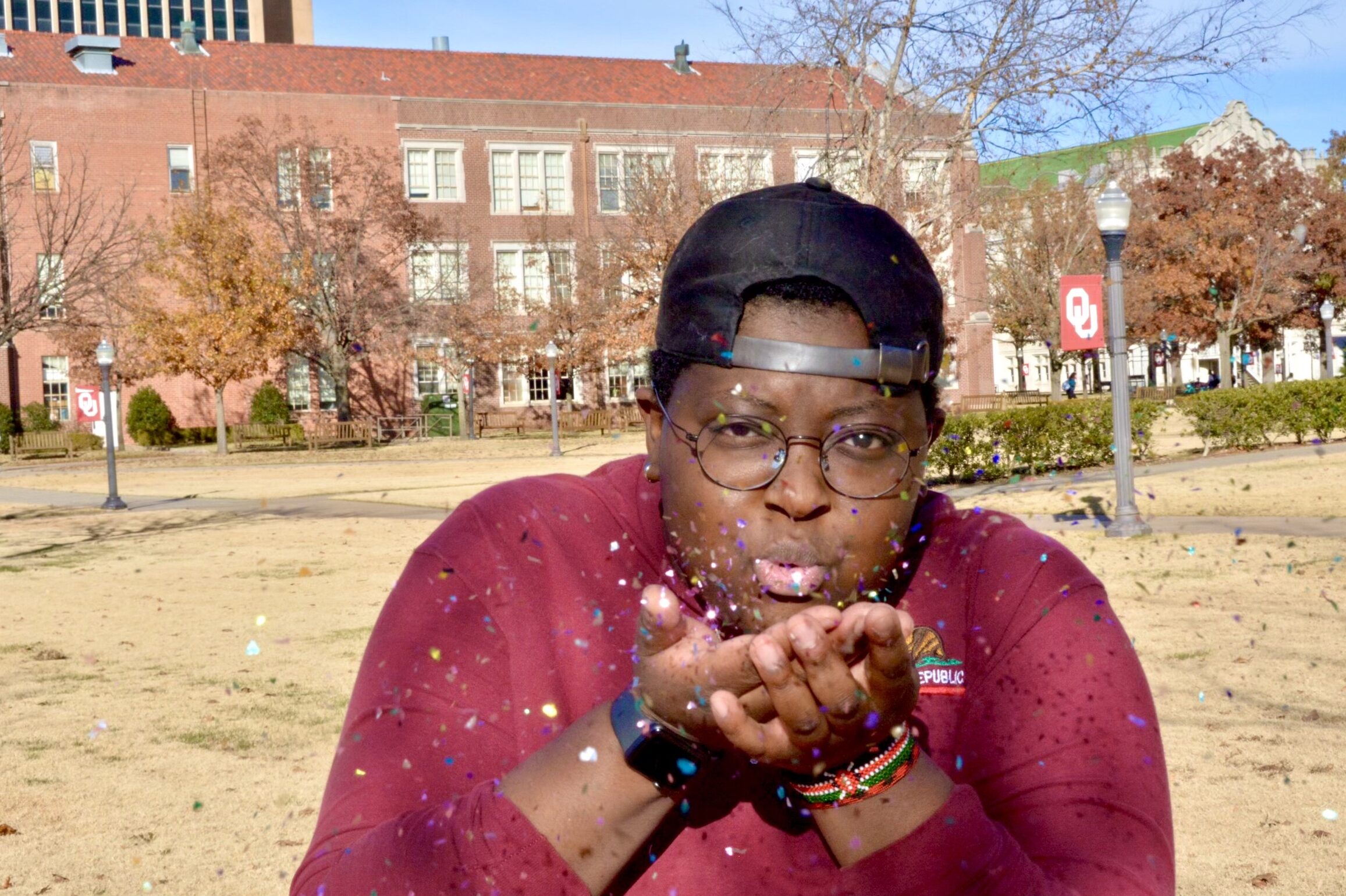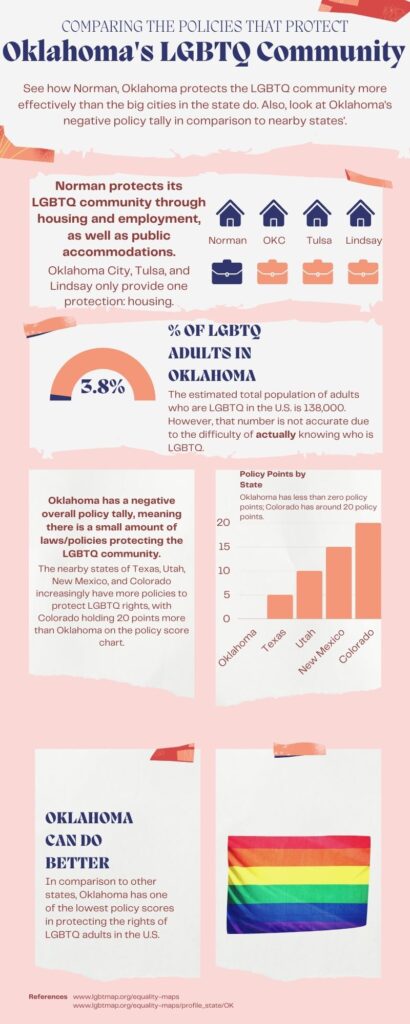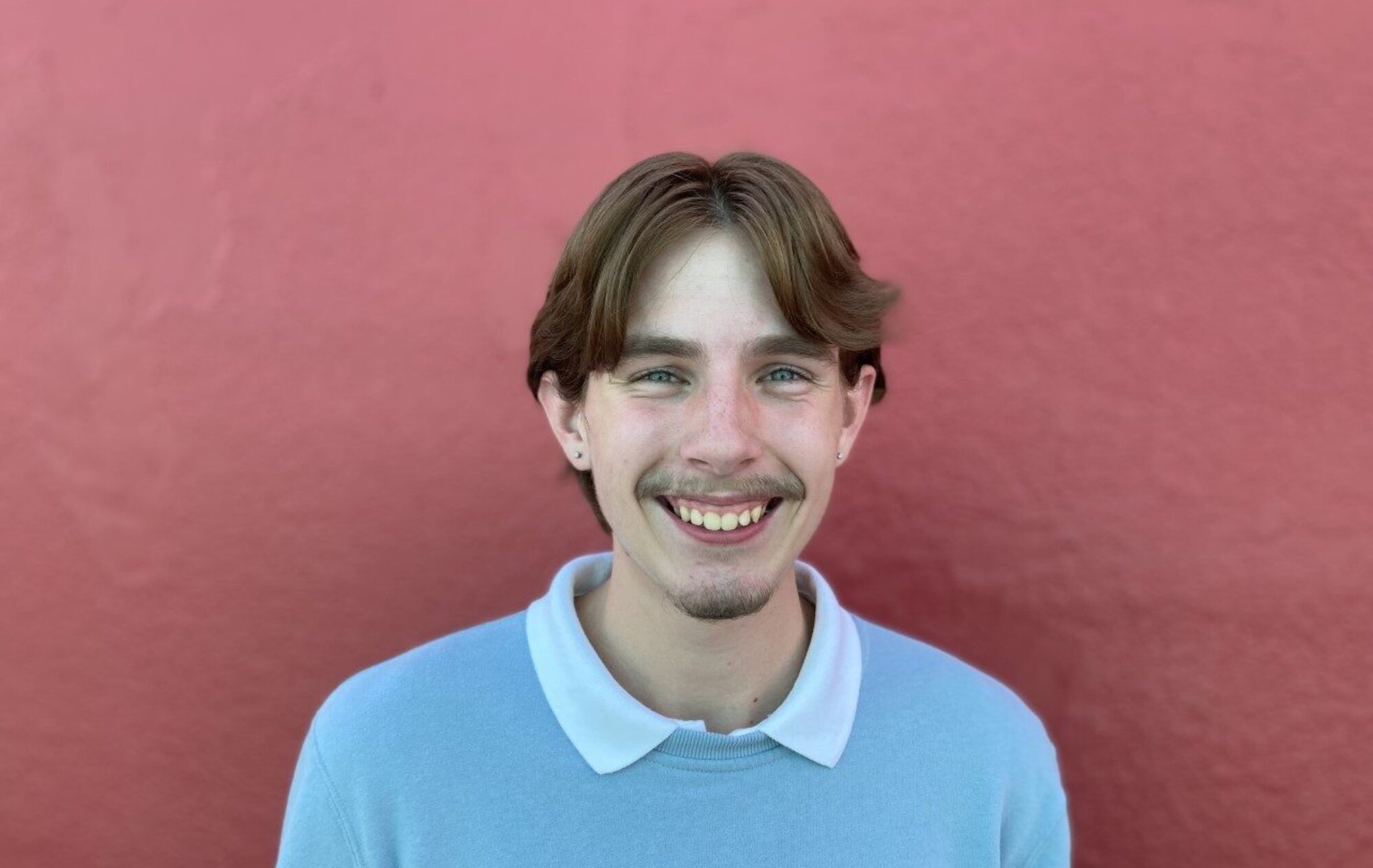By Spencer Bias

The LGBTQ community in Norman receives more protections than other communities in Oklahoma; however, the state’s policies display an inability to protect LGBTQ individuals in comparison to nearby states’ policies.
Jerry Lessley, a graduate teaching assistant who came to OU in 2014 from a small town in rural Oklahoma, said the Gender + Equality Center, commonly referred to as the GEC, has contributed to the Campus Pride Index’s consistent ranking of OU as the most affirming LGBTQ-positive school in Oklahoma.
“A lot of the criteria that they [Campus Pride Index] have are unfortunately beyond our control because of bureaucracy and living in a red state,” Lessley said.
“President Harroz cannot change some of the housing policies, like a state-level policy such as Housing and Food. With that, obviously there is room for improvement.”
Lessley started a program called Crimson & Queens in 2017 in hopes of creating an intentional space to affirm OU’s students, faculty, staff and alumni as truly a part of OU’s family.
“It’s easily the biggest drag show in the state, biggest in the region, one of the biggest annual shows in the country, and that’s happening in Oklahoma,” Lessley said.
“To sit back and realize that we have events like that specifically in a public university in the middle of a red state, it’s so weird. To be able to put something on like that for our community, is something I treasure.”
The GEC’s goal, according to its website, is to combat social norms and messages by helping many students become more comfortable in their sexuality, such as junior Hellen Ombachi, who began their coming-out journey during their senior year of high school in Edmond.
“OU definitely strives to make their diversity and inclusion programs one of the top. With the programs that they’ve implemented…for minorities and underprivileged groups, I think they’re doing a pretty good job so far,” Ombachi said.
Even aside from the GEC’s role in establishing new norms, the city of Norman has made further strides than any other city in Oklahoma.
“I would consider Norman the most inclusive city in Oklahoma because in 2019, Norman City Council became the safest place for LGBTQ identifying people in Oklahoma,” Ombachi said.
On Aug. 27, 2019, Norman became the first city of Oklahoma to pass an ordinance protecting LGBTQ individuals against discrimination. Nonetheless, there are no counties in Oklahoma that have an ordinance prohibiting discrimination based on sexual identity, not even in major cities such as Oklahoma City and Tulsa.
By Spencer Bias

Senior Caroline Sparks, who went to high school in Tulsa and came out her sophomore year at OU, said there were minimal attempts made by the administration to recognize the spectrum of sexuality.
“I did go to high school in the Tulsa area. Unfortunately, LGBTQ+ identities were not acknowledged. It’s one thing to acknowledge it in a negative way, but we weren’t acknowledged at all,” Sparks said.
“Something changes, I think, when people go to a public university if they have resources like the GEC.”
Sparks also said that the GEC highlighted resources in a way that made OU unique.
Caroline Sparks is a senior at the University of Oklahoma. Sparks is from California, but attended high school in Tulsa and began to see Oklahoma’s poor efforts to achieve LGBTQ equality. Sparks speaks about the Gender + Equality Center’s inclusiveness and successful actions towards equality in Oklahoma. Students greatly benefit from having resources, such as the GEC, that can draw individuals together to form a community.
“It’s unique for a university to even have an organization like the Gender Equality Center, given we’ve been oppressed for the past 20 years,” Sparks said.
The GEC also offers the space of a LGBTQ+ lounge to allow LGBTQ+ students to physically be in community with others, which Sparks described as “really special.”
“They have things like a lending library, educational resources. To have staff and faculty who take the time to get to know individuals and be in community with them, I think that’s really special too,” Sparks said.
While OU maintains a welcoming group of faculty and staff, many public high schools tend to have much less LGBTQ representation.
“Students in high school, I think in Oklahoma, still suffer a lot because most of the groups that are seen in high schools in Oklahoma are student-led out of necessity for the fact that they don’t have support from their administrators,” Sparks said.
Even administrators who work for the university, as well as people in positions of power, sometimes neglect to acknowledge the LGBTQ community.
“A lot of the time when it comes to people at OU–especially the president, the higher-ups–it’s more of a hush-hush situation that people don’t talk about things. They really try to save face for the university and themselves,” Ombachi said.
“With Kevin Stitt as the governor and being so conservative, he doesn’t really see LGBTQ people as people. Definitely having someone like that in a position of power is dangerous and that’s the reason I think we have a lot more work to do compared to certain states.”
Despite claims of President Joseph Harroz, Jr. failing to acknowledge the LGBTQ community, Harroz said he values diversity in a presidential statement.
“Students of all backgrounds and perspectives must feel they belong, or they will not flourish – and, as a result, the university will not flourish,” Harroz said.
“At OU, we cherish our diversity, in all its forms – intellectual, political, socio-economic status, race, gender, sexual orientation, religion, nationality, and more. Everyone has a voice, and each voice can and will be heard.”
Both the state of Oklahoma and OU have a lot of progress to make in terms of protecting LGBTQ individuals, leaving plenty of room for improvement in the future.
“I think what would help would be an open conversation and not being afraid to have those serious conversations that need to be had, and I think after that they will definitely make strides in that department,” Ombachi said.
“Gender-neutral restrooms, acknowledging that there are more than two genders, and having protections for LGBTQ, not only families, but individuals, are ways that Oklahoma can improve.”
While Oklahoma is shadowed by the successful protections of surrounding states’ LGBTQ communities, Norman acts as a starting point for beginning the change necessary to recognize the equality of LGBTQ individuals.
“The fight never ends. There’s never a stop to it. There’s not a cap that you can reach,” Ombachi said.
